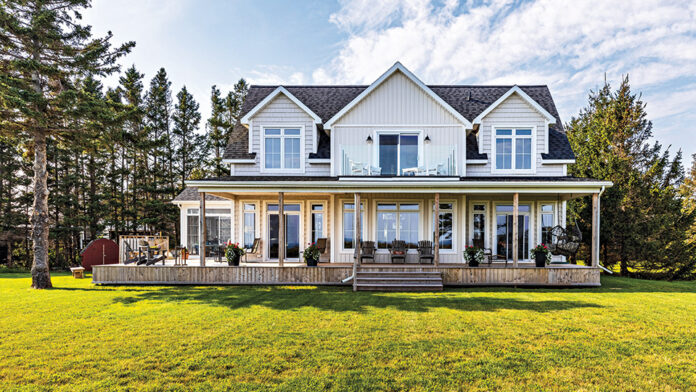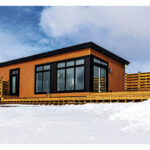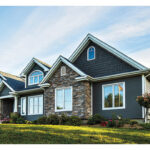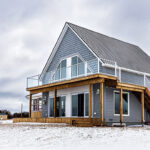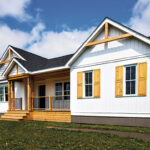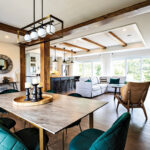By Natasha Rombough, Director of Marketing and Communications, CHBA
With nearly 25 years under his belt working to help build a manufactured home business, Frank O’Blenis has seen a lot of changes over the years working as a sales manager for Supreme Homes, a modular homebuilder with a factory in Tracadie, NB. The company serves all of Atlantic Canada, Quebec and Ontario. Frank plans on retiring soon after many years dedicated to the industry, and we took the opportunity to catch up with him and learn more about the family company that he helped grow.
Building on a vision
In 1983, Aristide Savoie started a small company in Tracadie, NB, building storage sheds and outdoor garages in the open air. That side of the company grew, and he also began to build stick-built homes. In 1995 he opened a factory with the intention of doing all construction indoors so that the product wasn’t exposed to the weather, and with the vision of one day expanding the business to building mini homes in the factory. In 1990, his son Robert, who is now the owner-president, began working with the company. As his summer student job in 1996, he was tasked with getting the firm CSA Certified.
In Canada, all buildings, including factory-built ones, must comply with the locally applicable building codes and regulations in effect, and that must be checked, verified and inspected against the requirements in the location they are built in. The CSA A277 certification verifies that factory-constructed buildings comply with local requirements. The certification body oversees the in-plant quality process, including identification of qualified personnel and responsibilities, sign-offs and record-keeping, and conducts annual audits and random inspections.
Supreme Homes received its CSA certification in 1997 and built its first mini home inside the factory, while continuing to make conventional stick-built homes. Two years later, things were going well, and Aristide Savoie was looking to expand. But his plan to buy out another modular plant in Amherst – three hours away – did not sound appealing to Robert, who was in the process of building a home with his pregnant wife. “Instead, we decided to expand the factory in Tracadie,” Robert says. “We went from 6,000 square feet to 42,000, and hired some of the people who worked at the Amherst business to work in it – Frank was one of them. We never looked back after that, just kept expanding.”
Creating a strong team
Frank was no stranger to the retailer model, and brought leadership with him to Supreme Homes. He’d worked for years for a door and molding manufacturer called Premdoor, which was based in Ontario and had factories all over Canada, the U.S. and Europe, including a door manufacturing plant in Amherst. Frank worked as a sales manager there before spending a few years working for the home manufacturer in Amherst that Aristide had considered buying out.
Frank truly made a home with Supreme, though, bringing his distribution network with him and developing and maintaining the relationships with retailers that are a main component of factory-built business models. He likens the arrangement to that of car dealerships that procure vehicles for purchasers; the retailers have offices and sometimes lots with showhomes on them, and they are the ones who bring in homebuyers, put in the order and handle the transaction, and arranging for the home to be “installed” onsite.
Supreme Homes continues to grow, and now employs more than 200 full-time employees. In the years that Robert and Frank have been working there, they are happy to note that their workforce has become more diverse. “More women are willing to work in this field now, which is a good thing,” Robert notes. “Twenty years ago, we only had cleaning ladies, but now young women are doing finish carpentry, cabinets, sheathing and more. They have fresh ideas and good attention to detail.”
Aristide retired in 2004, with Robert taking the reins. Since then, the company has been a modular builder exclusively.
Designing for the future
Today, the company specializes in single-family custom homes. It prides itself on pushing the boundaries of designs that are compatible with factory-built construction methods, such as models that range from having flat roofs to a 17-ft.-wide high-pitched roof, and styles can be called modern, traditional or Scandinavian. On average, it takes six to nine months to go through the process of conceptualizing a new design and making it available to homebuyers.
“When making a new design, we consider who the buyers will be, what current trends are and what shows well, and what will have lasting appeal. We are inspired by architecture in other countries, but it’s new to modular construction in Canada,” says Robert. “It would be boring to do the same house every day, and our employees like the variation; it’s challenging and fun.”
However, the nature of factory-built homes means the more the company builds a model, the better the return on investment, which is why designing for the future is important. Prospective buyers can see models that are available either on the retailers’ lots, or during open house days that Supreme hosts.
Committing to progress
Frank works from home, but often travels to visit retailers and to go into the factory. He’s also very committed to advancing the factory-built industry within Canada. He was on the board and served as president of the Canadian Manufactured Housing Institute (CMHI), and helped navigate the transition of merging CMHI and MHI Canada to create the CHBA Modular Construction Council in 2017. “The work that was being done in the local/provincial associations and at the national level of CHBA was valuable, not just for the industry but also for Supreme Homes,” Frank says of his steady involvement over the years. “The work that gets done behind the scenes is crucial for moving our industry forward.”
Robert agrees that there’s still work to be done. He says there while it’s improving, there’s still an existing stigma about their products, and it’s frustrating that people still need to be told that their homes built in factories are just as good (or better) than conventional stick-built homes, and that the benefits of being built indoors need to be explained. Once people come to the factory and see the product, they’re convinced, but it shouldn’t be necessary.
But the bigger hurdle is with governments, specifically bylaws and zoning challenges. “Governments are asking for more homes and better homes, and modular is the solution for improved efficiency and product,” Robert says.
He feels optimistic about the future. “We have a strong wind in the right direction for factory-built homes.
There’s a lack of labour and Canada needs to be more productive. Interest rates are going down, there’s strong demand and growth, and we have a government pushing for investment. General contractors have a lot of work just with commercial projects, so manufacturers can take on residential construction.” He’s already seeing a lot more modular construction locally, and says it’s rare now for an apartment or condo building to be built without some form of panelization. “In five to 10 years, you won’t see any more projects that don’t have boxes built in the factory. Things are changing and modular is the future.”
As for changing the stigma around factory-built homes, “It helps to see governments saying they’re coordinating their efforts with modular construction in mainstream media,” Frank points out.
For its part, Supreme Homes has been developing a new part of its business model that is centred on larger housing contracts with government entities. The company has completed three projects this year, with housing types ranging from duplexes and townhomes to apartments, all within Part 9 of the building code. Robert points to the government of New Brunswick as an example of things changing, as half of all units to be built were required to be modular.
Saying farewell
Frank plans to retire in January 2025, but if you ask Robert, he jokes it won’t be until much later. You can tell there is a good history there, the two having spent nearly 25 years working together. Frank credits his longevity with the company to their great working relationships. “Aristide and Robert, and now Robert’s son Yan, who is the third generation working with the company as its chief operations officer, have always treated me as if I was part of their family. They’ve always respected my input and treated me with respect. They’re just a really great family.”
The two have come a long way since first meeting, back when Robert thought Frank was Italian (Franco Blenis versus Frank O’Blenis) before finally greeting him face to face. “Hiring Frank was a gamechanger for us,” Robert says. “He’s dedicated to his work, and everyone loves him – he’s a great Maritimer with his heart in the right place. He’s always there for anyone, and he’s got a good ear, a good eye and a good soul.”
Frank says that in addition to the Supreme team, he’ll miss the relationships he’s built with retailers over the years. “There have some people I’ve been working with since 1999,” he says. “I can drop in with them outside work hours and they’d always be happy to see me. I’ll also miss the people at the plant that I’ve worked with for a long time.”
But he’s got a lot to look forward to, like more time to dance with his wife (they ballroom dance, waltz and square dance regularly) and to travel. He’ll continue to be proud of how far the industry has come, and where it’s headed.
Fast Facts
Company Name: Supreme Homes
Head Office: Tracadie, NB
Areas Served: NB, NS, Nfld., PEI, Que., Ont.
Full-Time Employees: More than 200
Retailers: 17
Projects/Homes per year: 250








